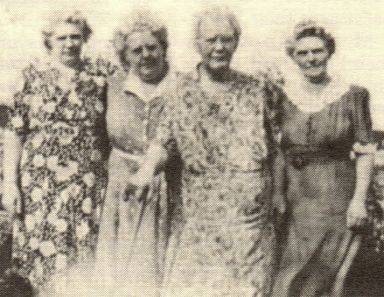McINTYRE, MARGARET (BRANNON)
by Earl Walker
Entry F285 from the History of Hooker County Nebraska
with permission of the Hooker County Historical Society

L to R, Fern Hanna, Ona Walker, Grandma McIntyre, and Euna Parrish
My grandmother, Margaret McIntyre,
known fondly in the Sandhills as `Grandma
Mac', was born 1867 in Morgan County, West
Virginia. When she was 11, her father,
Bushrod T. Bannon moved his family to York
County, Nebraska. He landed there with $.23
and a family of 10 children to support. The
family was fortunate to all secure jobs in York
County, they didn't make much money, but
they made enough to make a payment on a
house. My grandmother's father got a job as
a butcher and served as sheriff of York
County a year and later moved to Broken
Bow, Nebraska.
My grandmother, Margaret Brannon
(1867-1944) was united in marriage to
Edward Stephenson (1858-1902) in Broken
Bow where they lived for a period of time. To
this union 7 children were born: Euna (Mrs.
Ross Parrish), Earl, Ona (Mrs. Dr. D.A.
Walker), Ulala, Carl, Fern (Mrs. Seth P.
Hanna) and Gladys, who died at birth. Fern
Stephenson Hanna is the only living member
of this family.
The spring of 1887 they migrated west in
an immigrant wagon, a wagon that Edward
had traded for and being a blacksmith, it
wasn't difficult for him to fix. He also had
traded for a pair of big Oregon mares which
he was very proud of, too. They traveled 6
days and arrived in the Sandhills in a little
town not yet named Mullen. The railroad had
reached as far as Anselmo when they passed
through there. The Burlington route had
been surveyed through the Sandhills but only
accomplishment was the survey and designa-
tion of the stations every few miles. They
didn't have any grade or ballast for the
tracks.
Edward and Margaret had come to a
homestead near her father's claim. They
stayed with her folks until the sod house was
built. It took the men two weeks to build the
house. In building the sod house they used a
sod plow, followed by a man who turned over
the sod. They hauled the sod to the house on
a flat wagon. There were trees and brush
along the Middle Loup River that they cut for
the roof of the house. The closest place to
purchase items for their new home was
Anselmo. To get more desirable furnishings
they had to go to Kearney. They had a very
hard time making a living while they were on
this place. The first year, they raised only
corn, such as flint corn, a few potatoes and
a garden.
There were few settlers when my grand-
parents came in 1887, neighbors were about
50 miles from them so they would see nobody
for months, and welcomed visitors. A year
after they had lived on their homestead,
many immigrants came to the Sandhills and
was being rapidly settled from 1888 to 1900.
In 1900 and later, the big cattle companies
began to move in and take possession of the
land. There was the UBI Cattle Company run
by G.G. Ware, that ran about 5,000 head of
cattle, 12 miles south of Mullen on the Dismal
River. My father, Roscoe A. Parrish, worked
for this outfit about a year and half. There
was the Standard Cattle Company managed
by R.M. Allen, which ran about 20 to 25,000
head of cattle, located about 40 miles north
of Mullen, in a territory of forty miles square,
but was financed by a lot of eastern money.
My father also worked for this company for
4 years and also as foreman of a haying outfit.
This ranch was called the 1010 Ranch
because of their brand.
My grandparents lived for ten years on
their homestead, during the extension of the
large cattle companies. The seven children
were born, my mother, Euna, was born in
Custer County before they came to Mullen,
(she is deceased and buried in the Seneca,
Nebraska Cemetery). After this 10 year
period, my grandfather moved to Mullen
where he ran a livery barn, for four years. He
took sick with typhoid pneumonia at age 41
and passed away after suffering for 17 days,
March 27, 1902.
My grandmother continued living in Mul-
len after his death. She later married Harry
G. McIntyre and had twin sons, Lloyd and
Floyd.
My Mother, Euna Parrish, was one of the
oldest pioneers of the Sandhills. Quite a
contrast to the present day living in this area.
There were no fences, railroads, buildings,
roads, nothing but trails leading through the
country where people had traveled, going
west. Most followed the better road which
went by North Platte towards the west. The
hills are much sandier than they are today,
the tops were nothing but sand with plenty
of `blowouts'.
